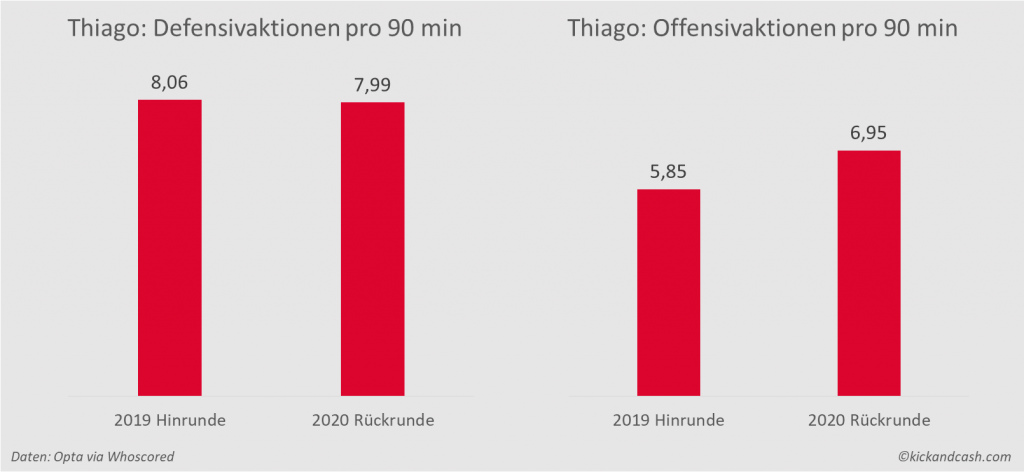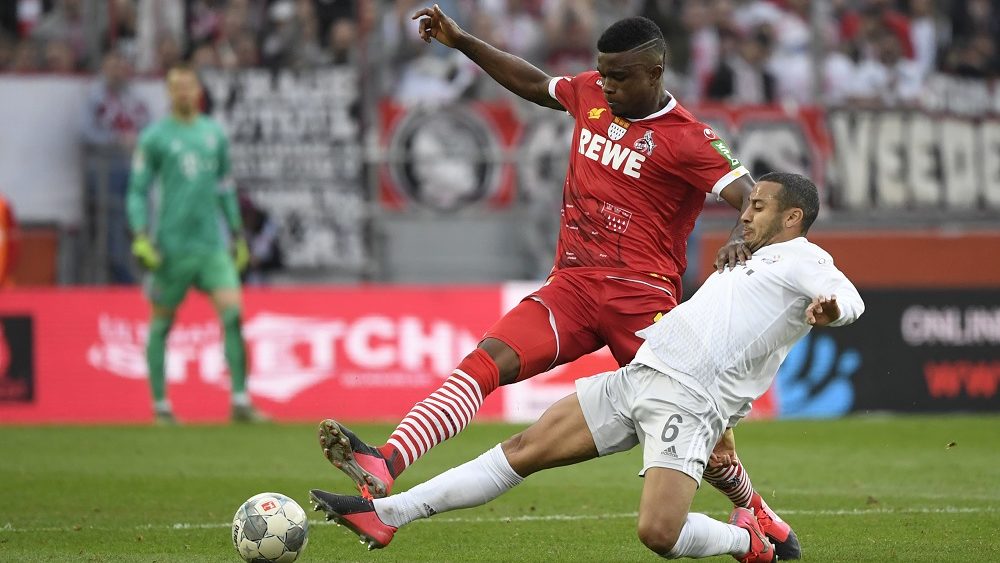Thiago the fighter
While the time without regular games poses manifold challenges to players, supporters, and the media alike, it at least affords a little breathing space for some more profound and thorough analyses and observations that might get lost in the shuffle in normal times.
The German football magazine Kicker, for example, recently wrote a portrait of Thiago, whose contract will expire in the summer of 2021, which naturally gives rise to some interesting speculations about his future.
According to Kicker, Thiago has changed from an artist to a worker
In their article on Thiago from 21 February, 2020, the Kicker describes the process of this transformation. They hold that the change in coach from Kovač to Flick prompted Thiago to fundamentally reconsider his style of play. He realized that playing football was not all about “aesthetic no-look passes”, but also contained such “basic elements” as “robust challenges and tackles”, particularly in a competition like the Bundesliga.

(Image: Stuart Franklin/Bongarts/Getty Images)
In doing so, the Kicker once more reinforcerd the equally well-established as unfounded contention that Thiago has been faced with ever since his arrival in Munich many years ago. He is considered a technical player with a lot of shiny moves no doubt, but if you want to succeed in Germany, you need to be willing to work hard and go the extra mile. And that is what he supposedly does not do.
The rate of challenges won is no evidence for the prevailing theory
Evidence to substantiate the claim? Hardly any. The Kicker’s conclusion is apparently based on a slightly improved rate of challenges he has won recently. However, there are certain issues with this particular statistic.
Weaknesses of the challenges won statistic
Martin Rafelt, author at spielverlagerung.de as well as a coach and analyst at Hajduk Split, already explained the problems with this statistic based on the example of a match of Dortmund against Augsburg several years ago: The main problem with any challenges-related statistic is that it is unclear what exactly constitutes a won or lost challenge. It is also quite uncertain what value a higher rate of won challenges really adds to a team.
One statistic alone does not say a lot
It should be noted that the rate of challenges won without the absolute numbers of challenges for perspective has to be treated with caution. With 9 challenges in a match, the difference between a celebrated 56% and a criticized 44% of challenges won is often only the difference of a single challenge (5/9 vs. 4/9 challenges won) in the primary data.
Considering the problems in data collection and the ambiguity of interpretation mentioned by Rafelt, this in itself should already give you pause.
There is not the one best statistic for challenges
Rafelt also rightly points out that there is no defined event of a “challenge” in the primary sports data Opta records. The figures regularly quoted in German sports media are computed from various Opta values.
It is therefore unclear whether the Kicker’s challenge statistic refers exclusively to defensive actions or whether offensive actions such as dribbles are included as well.
I have tried to reproduce the challenge statistics of the Kicker. Using the example of the match between FC Bayern and RB Leipzig, this looks as follows: According to the Kicker, Thiago won 73% of his challenges in that game. This figure could only be arrived at using Opta’s primary data if the following calculations were made: Tacklings (Thiago won 4, lost 1), aerial duels (2 vs. 1), dribbles (5 vs. 1) and turnovers (1). In total, this amounts to 11 won and 4 lost challenges, or 11/15 = 73%.
Combining offensive and defensive values
It is of course legitimate and often even useful to compile different primary data into more complex synthetic values. And there may be good reasons to specifically include dribbles as a form of challenge. But one should not make the logical mistake then of construing this rate as a sign of a defensive work ethic.
Or would anyone come up with the idea to praise Neymar for his defensive efforts after a game in which he had 7 successful dribblings from 8 attempts, conceded 2 turnovers and had 0 defensive actions, which, according to the above method of calculation, would amount to 70% challenges won?
Thiago has always put in a shift in defense
The rate of challenges won, especially if it includes offensive actions, is thus not a suitable approach to evaluating the defensive strength or defensive effort of a player. But then what is?
This question is not easy to answer. Football is too complex an exercise to be fully captured in simple statistical models. This is particularly true in modern high pressing football: If Thomas Müller triggers a pressing event by closing down the opposing goalkeeper so that he is forced to play an uncontrolled pass which is intercepted by Joshua Kimmich, is it Müller or Kimmich who has won the ball? Opta counts Kimmich as the player who intercepted the ball in their statistics, whereas Müller’s pressing action is reflected as such only in their advanced stats. But how do we evaluate the influence of Serge Gnabry and Kingsley Coman, who may have blocked other possible passing lanes for the goalkeeper?
Despite such limitations, the following chart shows a combined figure of Thiago’s defensive actions over time, which includes intercepted balls, tackles, fouls, blocked shots, and clearing actions. It is not a perfect metric for Thiago’s defensive quality, but it does show his willingness to work in defending, and it’s also a good way to look at his career progression.

The result is surprising, is it not? Thiago never had less than 8 defensive actions per 90 minutes. If anything, the figures have even been declining slightly since 2016.
So what does this say about the widespread narrative that Thiago, the offensive aesthete who [to get a new top contract] has finally discovered his passion for defending? And what does it say about the faculties of observation of the Kicker when they claim to have revealed a new defensive side to Thiago now, in March 2020 of all months?
Development in the Rückrunde
In the Kicker article Thiago is said to have had a cathartic moment during the training camp in Doha. From that event a new Thiago emerged, an “aggressive leader who fights tough challenges; a fighter who knows how to hit the ball hard and not just softly stroke it.” So could it actually be that Thiago has been much more committed to defending in the Rückrunde than he was in the Hinrunde?
Well, that is not supported by the numbers either. Thiago’s defensive actions in the 2019/20 season are almost identical for the first and second half of the season.

Actual performance improvement in attack
I agree with the Kicker on one thing: Thiago has improved considerably in the second half of the season. I myself said here on Miasanrot not too long ago that he showed a “clear improvement in performance after a moderate Hinrunde.”
However, the improvement in performance does not manifest in his defensive performance, but in attack. The three goals Thiago scored in the second half of the season compared to his zero goals in the first are the most substantial evidence of this.
He has also scored more often (1.3 shots per 90 minutes in the second half vs. 0.7 in the first half) and had more successful dribbles (3.6 in the second half vs. 2.9 in the first half).
Conclusion
Thiago has had the reputation of being a player for the aesthetically pleasing moments of a game ever since his arrival in Germany. Now there are worse things to be labeled with than that of playing beautiful football. This only becomes a problem because there seem to be only two categories of footballers in Germany may fall in: You are either an easy on the eyes artists or a hard worker. An Overath or Schwarzenbeck. A Scholl or Jeremies. Being both at once apparently is not possible.
But only apparently so, because Thiago proves the opposite. It is to be welcomed that the Kicker is finally beginning to acknowledge this after he has played 227 games for the German record champions.
Nevertheless, it is a pity that the Kicker wraps this epiphany in the old Thiago narrative of the fragile aesthete – who is now converted.












Thank you for the nice statistical analysis. Even without it, to my eyes Thiago has been the backbone, the pivotal cog of our Flick’s system. In a well functioning midfield it does not make a lot of sense to pick one individually, but still, I feel Thiago is the most difficult player to replace out of the 3s Thiago – Kimmich – Muller. Also with his quiet, down to the earth style, Bayern have a real model professional in their rank and they would be crazy not to extend with him at almost any cost.
The only thing I’m currently hesitant to him is his durability. He seems to get injury much less now, perhaps with more experience, and the change in diet and training, like what Robben did?
[…] Thiago the Figther, de pe Miasanrot.de, din punctul meu de vedere cel mai complet – sic, Dan! :) – blog despre FC Bayern. Autorii scriu în principal în germană, dar au și o secțiune (nu la fel de bogată) în limba engleză. Apropo: parcă v-am întrebat mai de mult, dar n-ar fi rău să-mi spuneți dacă (măcar unii dintre voi) vă descurcați cu germana, să știu pentru viitoarele recomandări. […]